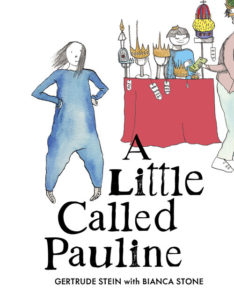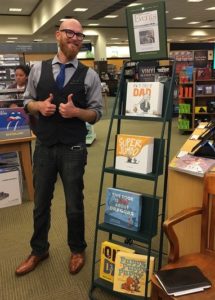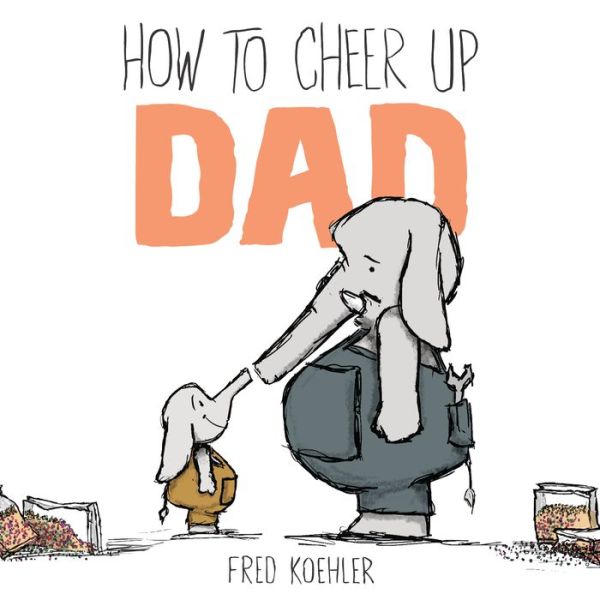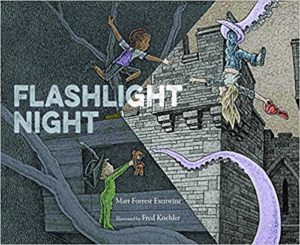 A Little Called Pauline
A Little Called Pauline
Author: Gertrude Stein
Illustrator: Bianca Stone
Penny Candy Books
14 April 2020
64 pages
This month’s PB review is by Ryan G. Van Cleave (Big-time Gertrude Stein fan at Only Picture Books) and Florida-based author/illustrator Fred Koehler.
–Ryan’s Review of the Writing–
Let me preface this review by saying that dozens of picture book hardcovers, softcovers, e‑versions, ARCs, and F&Gs arrive at OPB each month, and it’s hard to deny that more than a few have a sense of sameness to them. That’s not to say quality stories don’t land on my desk each month–some are quite strong! A few are even great. But it’s accurate to note that much of what I see follows traditional paths in how they story creators convey story. I say all this by way of explaining that when a picture book comes along that avoids well-trod paths, it stands out.
Enter A Little Called Pauline by the late-great Gertrude Stein, who first published this as a poem in her amazing 1914 book Tender Buttons. The poem isn’t some candy-coated version of poetry for kids with June-moon-spoon rhymes and surface-only clarity. And this new book is a vibrant, fresh take on a poem that might seem a bit disjointed in both logic and language.
Witness: “Bidding a wedding, widening received treading, little leading mention nothing.”
Or the lines that immediately follow the above: “Cough out cough out in the leather and really feather it is not for.”
Yet there IS a story here, thanks to the work of illustrator Bianca Stone, whose ink and wash sketches pair with Stein’s words to create a story about a girl who dearly wants a fancy, expensive crown for her birthday that’s more than the family can afford. The girl throws a tantrum, and has a Where the Wild Things Are imaginative trip out to sea in a little boat where she then has strange experiences that end up not quite being all she hoped for. In both stories, it’s Mom who provides an apt, tender moment to bring these tumultuous excursions to a satisfying close.
I applaud the inclusion of the Illustrator’s Afterword which discusses the storyness of this poem, and the poemness of this story, as well as Stone’s personal connection to the original “A Little Called Pauline.” The Afterword also invites readers to join in the visual interpretative fun via what Stone calls “Poetry Comics.”
Leave it to Stone–a poet-artist–to trust the power of poetry for its ability to reach young readers. Stone explains: “Poetry is not a mysterious riddle you must figure out. It is a continuous adventure with your own mind, and there are no wrong answers in how you interact with it. All it asks is that you do.”
And that’s what this welcome adaptation of a century-old poem does. It asks–insists, really–for interaction and response that few readers can deny.
4.5 out of 5 pencils
–Fred’s Review of the Illustration–
Anytime an artist successfully pushes boundaries within a genre, they’re creating new spaces for other artists to experiment and play. In A Little Called Pauline, two bodies of art are separated by over a hundred years and yet somehow they sing in a weird and satisfying harmony.
Yes, I credit this book with having two artists. Gertrude Stein wrote the words in her 1914 poetry collection Tender Buttons. At first blush, they’re so strange that you wonder if it’s a bad translation. But the more you look at lines and say them out loud, the more sense they make. The words make art all by themselves, almost as if they’re a magic spell and by reading them you’re falling under its influence.
Then along comes Bianca Stone, who addresses the text as if she understood exactly what Stein was meaning to say all along. Around the nonsense, she wraps a parent/child narrative that’s equally intriguing. I love the ink and watercolor style that draws the eye to important details. It’s fun to go back through and see what you missed the first time.
If you skip the words all together, you’ll understand the story. But when you add in the poem, you end up with something oddly wonderful that seems perfectly appropriate, and potentially a healing force, for the strange world we live in today.
I can’t wait to see what Bianca Stone comes up with next.
4 out of 5 crayons
 Fred Koehler is an artist and storyteller whose real-life misadventures include sunken boats, covert border crossings, and fighting off robbers in the dead of night. Whether free diving in the Gulf of Mexico or backpacking across Africa, Fred’s sense of adventure and awe of nature overflow into his characters’ stories.
Fred Koehler is an artist and storyteller whose real-life misadventures include sunken boats, covert border crossings, and fighting off robbers in the dead of night. Whether free diving in the Gulf of Mexico or backpacking across Africa, Fred’s sense of adventure and awe of nature overflow into his characters’ stories.
Fred is passionate about encouraging young artists, promoting social justice, and conserving our environment. He lives in Florida with his wife, kids, and a rescue dog named Cheerio Mutt-Face McChubbybutt.







